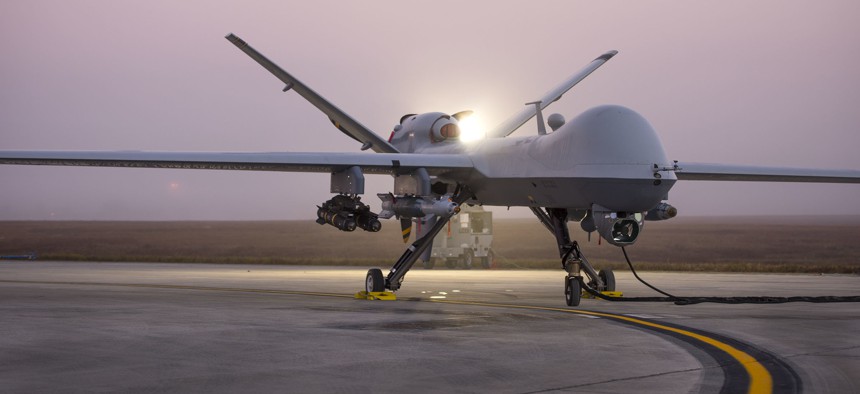
An MQ-9 Reaper sits on the flight line as remotely piloted aircraft crews wait for the fog to clear during Combat Hammer Nov. 6 at Duke Field, Fla. (U.S. Air Force photo/Ilka Cole
The Reaper UAV Is Getting Its Own Drone Swarm
Air Force special operators are rigging the venerable uncrewed aircraft with an ISR swarm that may take just one person to control.
The venerable Reaper UAV could become a mothership for a single-operator drone swarm, the head of Air Force Special Operations Command said recently.
AFSOC’s Adaptive Airborne Enterprise project aims to develop highly autonomous swarms of drones for intelligence, surveillance and reconnaissance—and perhaps even strike, Lt. Gen. Tony D. Bauernfeind told an audience at the Global SOF Special Air Warfare Symposium in Fort Walton Beach, Florida. The project also aims to reduce the number of humans needed to control such a swarm down to just one operator.
“A2E is a three-phase initiative to develop airborne human-machine teams commanding a family of uncrewed and optionally crewed” aircraft, Bauernfeind said.
These swarms of Group 1 and 2 drones—essentially, ones weighing up to a few dozen pounds—would launch from MQ-9 Reapers and perhaps other medium-sized uncrewed aircraft, he said.
The overall vision is to use artificial intelligence and advanced human-machine Interfaces to allow operators to control multiple large and small drones simultaneously. That would help AFSOC troops cover more terrain and hit more targets with a variety of effects, including cyber, electronic warfare, etc.
With a 30-hour endurance and decent payload, the Reaper has long been a cornerstone of U.S. special operations forces’ ISR efforts.. But the way the United States used the platform during the wars of Afghanistan and Iraq hardly fits with the idea of an “unmanned” aircraft. Human crews, sometimes thousands of miles away, would spend long hours piloting the drones, observing events on the ground and analyzing the footage, so much footage that AFSOC eventually launched an AI program just to help analysts sift through all the video.
Bauernfeind’s vision also suggests an upgrade to the interface that drone crews use to pilot unmanned aircraft—something more like a laptop instead of a massive trailer in the Nevada desert.
“In contested or denied environments, AFSOC is shifting from multiple operators controlling a single MQ-9A to a single air commando directing a family of systems,” AFSOC spokeswoman Lt. Col. Rebecca Heyse said in a statement. “MQ-9 units will leverage multiple platforms and incorporate autonomy and eventually Artificial Intelligence technologies to deliver capabilities to SOF, the Air Force, and the joint force across the spectrum of operations. A2E will increase the number of platforms AFSOC operators can manage by an order of magnitude, and through those systems, cover more terrain and prosecute more target across the spectrum of operating environments,”
AFSOC will take possession of its first MQ-9B by the end of the calendar year, Heyse said.
“The MQ-9Bs currently slated for AFSOC will not be used operationally. They will be used to rapidly pathfind A2E concepts and technologies, planned to include sUAS and autonomy integration, beginning in calendar year 2024.”
Don't miss:




